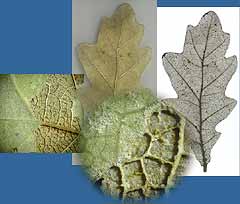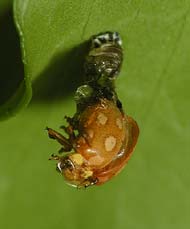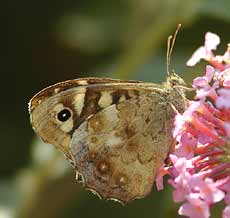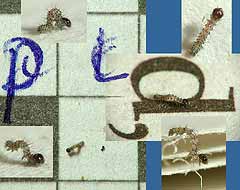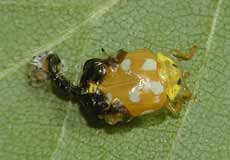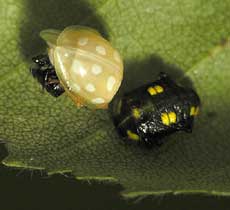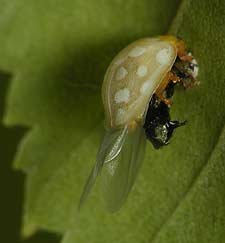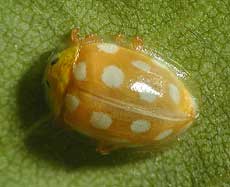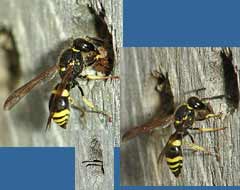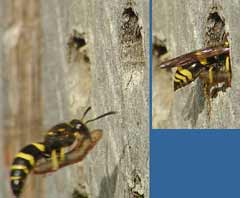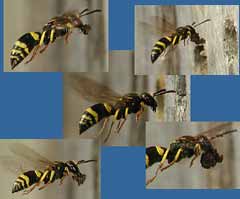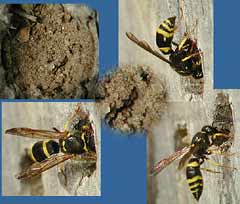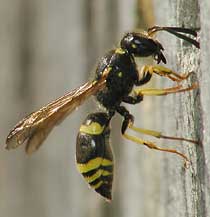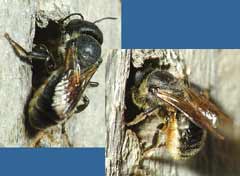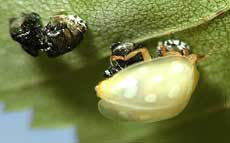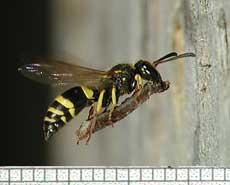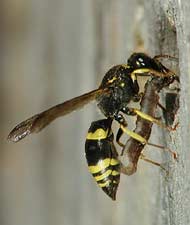Go to latest entry.....................................Go to previous entry3 September - The work at the bottom of the garden is taking over most of my time at present, but today I needed to take a day off as I've run out of steam! This has given me the chance to try to take a few photographs, although there were also a few lost opportunities.
By the time I got back to the house and collected the camera the woodpecker had gone. However, it was replaced by a flock of Long Tailed Tits. I managed to sneak down to near them but could only get these two images. The one time I had a clear view the bird was only about 5ft away - too close for the camera to focus on!
I first saw the larva, called an Oak slug worm a few days ago but I was too busy to take a photograph then. Today I could not find any so the pictures show the damage done by them. They feed on the underside of the leaves, eating away all the soft tissues, leaving only the skeletal leaf with the upper surface still intact. The two images of the whole leaf show it with front lighting (left image) and then with back-lighting to show the skeletal appearance. The larvae are the young of a species of saw-fly (Tenthredinidae family), probably a Caliroa species.
I have only seen one adult ladybird so far and this afternoon I found this, not on the usual Birch tree but on the underside of an Ivy leaf that is in contact with the Birch. Obviously it is an adult that is mostly emerged from a pupa, something I was hoping to photograph. I know these things happen very slowly but over six hours no change was seen, so unfortunately I don't think the ladybird has survived the metamorphosis.
4 September - Another beautifully sunny day, most of which was spent at the bottom of my garden trying to get done a bit more of the planned changes. Tonight I'm feeling shattered, so perhaps tomorrow may be another day off!
I saw a number of other butterflies in the course of the day, including some Large Whites, a Tortoiseshell and a Red Admiral. Several dragonflies passed through, although I didn't see any land.
The leaf-cutter bees seem to have ended their activities now. There has been some activity since we came home from our holiday but I have seen no sign of them the last few days. The bumble bees from the nest by the pond are still active, and today there were at least two types of solitary bee and a solitary wasp active at the bee hotel. If the weather is good tomorrow I may try to get some pictures of the wasp, if it's still about.
6 September - Other than a brief shower at lunchtime, today has been another bright, largely sunny day. I did a little bit more work down the garden this afternoon, having done nothing yesterday. Since I mentioned the bee hotel in my last entry there has been no activity there at all. It may be because, despite the sunshine the last two days have been cooler. I did see a large, long and slender ichneumon fly (parasitic) on our verhanda but it didn't stay long enough to be photographed. There were two types of butterfly about today, numerous Large Whites and several Speckled Woods.
To give you an idea of scale, the crossword squares are about 5.5mm across and the letter d is 4.5mm tall. I am a bit confused over the general identification as it has three pairs of true legs at the front, but appears to have only three pairs of prolegs at the rear. Butterfly and moth caterpillars normally have five pairs, and sawflies more than five pairs. On the bird front things are quiet at the moment. The House Sparrows continue to dash between the trees and the feeders, and the Dunnocks are now regulars again below the Hawthorn. The Blackbirds and Robins are appearing occasionally and several Blue Tits seem to be spending more time here now. Yesterday I caught a glimpse of a wren under the cover of the Ivy tree. This afternoon we watched a period of courtship between two Collared Doves in our neighbours' Birch tree. The session ended with mating. I shall have to watch out for signs of nest building. There are still House Martins flying about, and yesterday evening I watched the Starlings as several hundred of them flew over, heading west to roost.
7 September - A mainly cloudy day, although it has stayed dry, except for just a few spots of rain a couple of times in the afternoon.
At the time I took the picture the ladybird was definitely alive, but by the end of the afternoon no more progress had been made and it looks as though it has died. This is very disappointing after last year's successes. I have only seen one live adult so far. I don't think that weather conditions are much different to this time last year, so I'm at a loss to find an explanation for these failures, which didn't happen at all last year. In yesterday's notes about the birds I should have mentioned that a female Chaffinch is again a regular under the Hawthorn. One of the first sights I had when I looked out this morning was one of the Collared Doves disappearing into the conifers beyond the bottom of the garden - she(?) was carrying a twig! A bit later, when I was doing some sorting out down the garden one of them landed a few yards away and started picking up twigs. She would pick one, hold it in her beak for a few moments, discard it, and move on to another one. It was as though she was testing them. She carried on doing this for a minute or so, getting closer to me until she finally found one she liked just a yard from me as I stood there out in the open. She spread her wings and took off, heading to the nest site almost straight up from us. The woodpecker was about again this morning, not on the Birch tree this time but calling from a neighbour's chimney. The Sparrowhawk made two visits - Its second attack saw it flying right in front of us and into the Hawthorn as we were having a meal outside. Despite there being a couple of dozen terrified sparrows in the tree, I think our startled reactions put it off, and it left without a victim.
9 September - Yet another dry day, good enough this afternoon to sit outside and enjoy the sunshine, which was good as my chronic fatigue has really been uncomfortable today.
In this picture taken this morning it is on the right, and on the left the other pupa completed its metamorphosis this morning and an adult had emerged by the time I went down the garden to check on it. This time there were no complications and I saw the ladybird walk away, looking perfectly formed.
A couple of branches away another was at a slightly earlier stage in that it had not yet draw its hind wings in under the cover of its spotted elytra (modified and hardened front wings). This one also walked away a short time later, so my fears a couple of days ago of a failure this year have now been largely allayed.
A few minutes later I also found this adult, far from any pupal moult. It looks as though it emerged recently, but its orange colour is already darker than the newly emerged individuals above. Click on the images to see larger versions There are several more pupae to check on over the next few days in the hope of getting that elusive pictures of the emergence itself. Unfortunately, the forecast for the next two days is a bit pessimistic so I hope they hang on until that passes over! 10 September - It actually rained last night, but the day was dry, save for a few drops early this evening. Temperatures remain warm both by day and night at the moment.
It is a potter wasp and I think the species is Ancistrocerus parietum. The hole it is using measures about 7.5mm across, and had been used by a solitary bee last year. As I watched it this afternoon the first job was obviously to clear out the hole, which he did by simply pulling out bits (left-hand image) and dropping them immediately outside the entrance and then going back in for more. Later she started flying off and returning after a few minutes with small lumps of mud (right-hand image), spending several minutes inside the hole between each trip. I kept watch for over an hour in the late afternoon but activity slowed to nothing by 5pm and the last sight I had of her was when she appeared at the entrance head first (bottom image) having turned round inside the hole, and then reversed out of sight. If my identification is correct she will hunt for one or more small caterpillars to provide food for any eggs she lays. I have left my tripod in place so that I can simply click my camera into the same position tomorrow, when I may end up watching the hole for a long time! A medium-sized black and yellow potter wasp. It nests in a wide variety of cavities including walls and is known to prey on lepidopterous larvae.
12 September - Yesterday was a dull, and sometimes damp day and there was no activity by the wasp, who stayed in the hole all day. In contrast, today was sunny, although there was a thin film of high cloud over much of the sky. Before I settled down to watch for wasp activity I thought that I had time to do a bit of pruning.
It was one of those times when I curse the very narrow depth of field you get when doing close-up photography. The wasp's approach is erratic and although I took two shots as quickly as possible I'm afraid that these images were as good as I could get. The wasp's abdomen is extended in flight - notice the gaps between the yellow stripes. Over the next three hours I saw two more caterpillars (?) being carried by wasps but neither was brought to this hole, so I assume that there is at least one other similar wasp nesting nearby. During that time I only saw the pictured wasp leave the hole once, and then only return carrying nothing that I could see. I hope to spend a bit more time watching again tomorrow. On the Orange Ladybird front, I haven't seen anymore adults emerging but I have pinpointed the positions of seven more pupae and another larva which is about to pupate. I will be following their progress.
13 September - Another brilliantly sunny, largely cloudless day, much of which was spent keeping watch over the wasp.
Whenever it left the hole it always headed out of the garden in a southwesterly direction, up over the trees and was sometimes gone for as much as 20 minutes. When it returned it sometimes brought nothing while at other times it seemed to be carying mud or, what looked like decayed plant matter(?)
By lunchtime it was obvious that she was now sealing the hole, a task completed by 1.25pm. A closer inspection of her handiwork showed the presence of sand grains in the mixture she used for the seal, which dried very quickly in the afternoon sunshine.
Just after 3pm she emerged and then reversed into the hole and remained hidden for the next hour or so. I couldn't keep watch all the time but I did see her flying again around 5pm.
Over the last few days as I have concentrated on the wasp, there has also been a solitary bee active just centimetres away. Just like the wasp, she was sealing the entrance to one hole by lunchtime and she also moved into another hole this afternoon.
The Orange Ladybird larva I pictured at the end of August as it prepared to pupate is now an adult, as of this morning, and, as usual I missed the moment!
14 September - Another warm, sunny day meant that the potter wasp was active almost as soon as the sunshine reached the bee hotel, and this morning I had my camera set up ready!
After hesitating in front of a hole lower down the timber she flew up and I was able to grab the two images as she arrived. In this first shot the bright sunlight makes it almost impossible to distinguish the hole that is right in front of her.
As soon as she makes contact with the wood the opening was shown up more clearly by the shadows, and she paused just long enough to capture this clearer image of the larva. It doesn't appear to be a caterpillar (lack of prolegs) so I need to investigate this further. In the first image, the mm scale was photographed with the camera on the same settings and the added to the image. |
|
2003 Garden Diary Index..........Last Month...... .....Second part of September |

